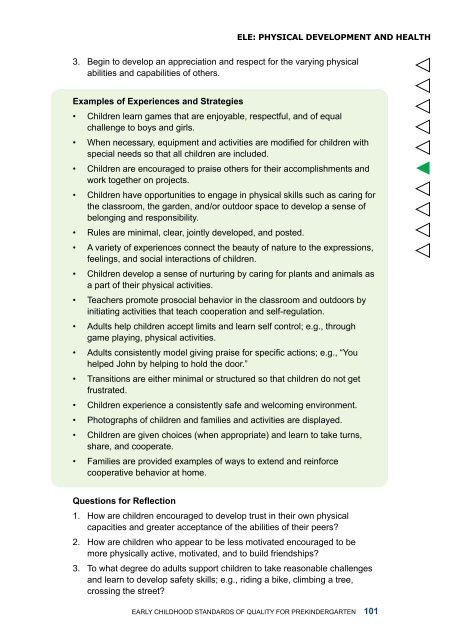Early Childhood Standards of Quality for ... - State of Michigan
Early Childhood Standards of Quality for ... - State of Michigan
Early Childhood Standards of Quality for ... - State of Michigan
You also want an ePaper? Increase the reach of your titles
YUMPU automatically turns print PDFs into web optimized ePapers that Google loves.
ELE: Physical Development and Health3. Begin to develop an appreciation and respect <strong>for</strong> the varying physicalabilities and capabilities <strong>of</strong> others.Examples <strong>of</strong> Experiences and Strategies• Children learn games that are enjoyable, respectful, and <strong>of</strong> equalchallenge to boys and girls.• When necessary, equipment and activities are modified <strong>for</strong> children withspecial needs so that all children are included.• Children are encouraged to praise others <strong>for</strong> their accomplishments andwork together on projects.• Children have opportunities to engage in physical skills such as caring <strong>for</strong>the classroom, the garden, and/or outdoor space to develop a sense <strong>of</strong>belonging and responsibility.• Rules are minimal, clear, jointly developed, and posted.• A variety <strong>of</strong> experiences connect the beauty <strong>of</strong> nature to the expressions,feelings, and social interactions <strong>of</strong> children.• Children develop a sense <strong>of</strong> nurturing by caring <strong>for</strong> plants and animals asa part <strong>of</strong> their physical activities.• Teachers promote prosocial behavior in the classroom and outdoors byinitiating activities that teach cooperation and self-regulation.• Adults help children accept limits and learn self control; e.g., throughgame playing, physical activities.• Adults consistently model giving praise <strong>for</strong> specific actions; e.g., “Youhelped John by helping to hold the door.”• Transitions are either minimal or structured so that children do not getfrustrated.• Children experience a consistently safe and welcoming environment.• Photographs <strong>of</strong> children and families and activities are displayed.• Children are given choices (when appropriate) and learn to take turns,share, and cooperate.• Families are provided examples <strong>of</strong> ways to extend and rein<strong>for</strong>cecooperative behavior at home.Questions <strong>for</strong> Reflection1. How are children encouraged to develop trust in their own physicalcapacities and greater acceptance <strong>of</strong> the abilities <strong>of</strong> their peers?2. How are children who appear to be less motivated encouraged to bemore physically active, motivated, and to build friendships?3. To what degree do adults support children to take reasonable challengesand learn to develop safety skills; e.g., riding a bike, climbing a tree,crossing the street?<strong>Early</strong> <strong>Childhood</strong> <strong>Standards</strong> <strong>of</strong> <strong>Quality</strong> <strong>for</strong> Prekindergarten 101


